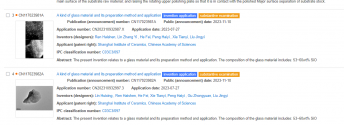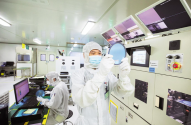 Technical field
Technical field
The invention relates to a glass material and its preparation method and application. Specifically, it relates to an ultra-fine crystallized extremely low expansion transparent crystallized glass and its preparation method. In particular, it relates to an optical system and a workpiece table for EUV lithography machines. Ultra-low crystallite glass for mask table and preparation method thereof.
Background technique
Transparent ultra-low expansion glass materials have been widely used in workpiece stages, mask stages and optical objective lens systems in photolithography machines. In particular, the requirements for ultra-low expansion glass materials in optical systems are very high. In addition to the extremely low thermal expansion coefficient ≤10ppb/K, the requirements for internal defects and processability are also very high. Extreme ultraviolet lithography (EUVL) is a microelectronic lithography technology that uses EUV rays with a wavelength of 11 to 14 nm as the exposure light source. It is suitable for the mass production of integrated circuits with a feature size of 32 nm and finer line widths, so it is different from i- line to the design of the transmission optical system of the DUV lithography machine. In order to achieve the production of chip products of 3nm and below, the EUV lithography machine adopts a 6 or 8 mirror reflective exposure system. All optical parts are coated with multi-layer films. Aspheric reflective optics. And in order to meet the quality requirements of lithography imaging, the aberration of the EUVL optical system must be controlled within 1nm. Wave aberration needs to be carefully allocated to every detail factor that affects imaging quality, such as mirror base, film thickness, etc. Since the mid- and high-frequency roughness of the working surface of the component directly affects the image plane contrast and system energy transmission, the surface shape accuracy and roughness of the component must reach the deep sub-nanometer level. After 20 years of development, the German Zeiss Company has been developing EUV lithography machines under the needs of the Dutch ASML company. With the improvement and improvement of wave aberration, component surface roughness and multi-layer film thickness requirements, EUVL optical processing, assembly and adjustment And coating technology is becoming increasingly mature. Large-diameter EUVL components with an optical element surface shape error and medium and high-frequency roughness processing accuracy of 0.1nm rms have been integrated into the EUV optical system, and the wave aberration of the EUV optical system has reached the diffraction limit.
Currently, high-quality ultra-low expansion transparent glass materials used in lithography machine systems are divided into two categories: microcrystalline ultra-low expansion transparent glass and amorphous ultra-low expansion crystallized glass.
Microcrystalline ultra-low expansion glass material is a Li 2 O-Al 2 O 3 -SiO 2 system ultra-low expansion transparent glass-ceramic with nano-β-quartz solid solution as the main crystal phase, and the crystal grains of the β-quartz solid solution phase are precipitated The size is 50~80nm, which is 1/10 of the wavelength of visible light, and the refractive index of its crystal phase is similar to that of glass, so it has high transmittance in the range of visible light and infrared light, and it also has negative expansion of β-quartz. The volume fraction of the solid solution (above 70%) and the volume fraction of the expanding remaining glass liquid can be well matched to form a nearly ultra-low expansion coefficient (7-20 ppb/K). Due to its near-zero thermal expansion, excellent three-dimensional overall uniformity, good processing performance, can be polished to extremely high precision, good coating properties, low chemical helium permeability, excellent chemical stability and other characteristics , Ultra-low expansion transparent glass-ceramic material is the core base material of the mask frame in the mask stage system of DUV and EUV lithography machines, which carries the wafer to complete preprocessing and exposure. At present, the microcrystalline ultra-low expansion glass-ceramic material used in lithography machines is manufactured by Schott Company of Germany.Expansion Class 0SPECIAL grade and ZERODUThe thermal expansion coefficients of Expansion Class 0 EXTREME ultra-low expansion glass-ceramic materials can be 7ppb/K and 10ppb/K (0~50℃) respectively (relevant patent numbers WO2015124710 (A1), DE102010002188 (A1)).
Table 1 is a performance comparison table of ultra-low expansion transparent glass-ceramic materials from different companies.
Amorphous ultra-low expansion glass is a titanium-containing silicate TiO 2 -SiO 2 low expansion glass represented by the Corning ULE system and produced using the same vapor deposition process (relevant patent number WO20141085529 A1). Its thermal expansion coefficient is very At nearly 0 ppb/K, this glass is designed to meet the masking needs of EUVL applications and as an optical substrate for UV lithography. At the same time, Japan's Asahi Glass and Nikon both have relevant patent layouts in this area (CN 104395248 B and CN102421713 A). The shift in lithography technology from 193nm to 13.4nm requires a major design shift from refractive to reflective in stepper optics. In reflective optics, the substrate material should be purely passive. Incident light should be reflected off the multilayer coating of the optics and photomask without introducing any mechanical or optical distortion caused by the underlying substrate. To minimize distortion caused by small temperature changes and meet stringent EUVL specifications, substrates must have a near-zero coefficient of thermal expansion (CTE, ppb/K level) and low peak-to-valley (PV) CTE variation. Currently successfully used in the optical system designed by Zeiss Company for the new generation of ASML Company's EUV lithography machine 3400 in.
Table 2 Corning Company’s ultra-low expansion glass material performance table
Research shows that there are two main reasons why microcrystalline ultra-low expansion glass-ceramic materials, mainly produced by Schott Company of Germany, cannot be used in optical reflective elements in EUV lithography machines: First, the elastic modulus of the microcrystalline glass material , Poisson's ratio and other mechanical properties are better than ULE glass, so the progress of ion beam polishing is slower; second, microcrystalline glass is composed of 50-80nm β-quartz solid solution phase and residual glass phase. Due to the ion beam The processing rates of the two are different, which makes it difficult for the high-frequency surface roughness to reach the 0.12nm rms required by EUVL, which is as high as 0.5~0.7 0.12nm rms; thirdly, most ultra-low expansion glass-ceramics contain B 2 O 3 , Ingredients such as Na 2 O and K 2 O are not conducive to the coating process.
Contents of the invention
The purpose of the present invention is to provide an ultra-fine crystallized extremely low expansion transparent glass-ceramic material for EUVL lithography machine optical reflection elements, which has an extremely low ±(0.5~10) ppb/K (-50~150°C) thermal expansion coefficient , high optical properties and excellent performance uniformity, 5-10nm β-quartz solid solution Li 2 O-Al 2 O 3 -SiO 2 system glass-ceramics, which can meet the application requirements of basic materials for optical reflective elements of EUVL lithography machines .
Another object of the present invention is to solve the above problems and provide crystallized glass with extremely low expansion characteristics and a manufacturing method of the crystallized glass element.


